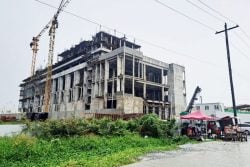Now retired, Ulric (Neville) Trotz was formerly the Deputy Director & Science Adviser, Caribbean Community Climate Change Centre, Belmopan, Belize.
Hurricane Beryl, which recently swept across the Caribbean leaving destruction in its path, is a harbinger of future climate change, as predicted in the several warnings issued by global climate scientists and in the reports of the International Panel of Climate Change (IPCC). Beryl is designated as the first ever category five hurricane forming in the Atlantic so early in the hurricane season. It also displayed characteristics of recent storms in its rapid transition from the status of a tropical storm to that of a category five hurricane. The latter can be attributed to the persistently higher Sea Surface Temperatures which provide a source of energy to fuel the hurricane and favourable wind conditions that facilitate the rapid transition to a major hurricane.
This is the new reality that faces us. We are living in a world “committed” to climate change as a result of the present level of Green House Gas (GHG) emissions in the atmosphere, and we cannot avoid the climate related disasters that we are now witnessing. As we continue the pursuit of actions to drastically reduce the concentration of Green House Gases in the atmosphere, in accordance with the Paris Agreement, it is imperative that equal attention is accorded to building climate resilience across all of our social, economic and environmental systems, so as to mitigate the impact of the predicted climate related disasters resulting from episodes such as Beryl.
The scientific community has been vocal in their advocacy for urgent action to mitigate climate change, through actions that reduce the GHG concentrations in the atmosphere ( e.g. cessation of use of fossil fuels, reduction of methane emissions) and for countries to build climate resilience through the implementation of appropriate adaptation measures that protect our social, economic and environmental systems from the devastation of climate related disasters (changed rainfall patterns, floods, droughts, increased intensity of extreme events, hurricanes, sea level rise and elevated Sea Surface temperatures). The most recent reports on global action to reduce GHG concentrations in the atmosphere show that we are lagging in our collective commitment to achieve the 1.5 degree limit to global warming, mainly as a result of the unwillingness of the major polluters to take the desired actions for its achievement.
Given these circumstances, developing countries and particularly our CARICOM States, which are extremely vulnerable to climate change shocks, must place the highest priority on implementing measures that would protect their lives, infrastructure, health, water, agriculture and critical ecosystems which contribute to their safety and livelihoods. Everything we do, be it investing in new development like in Guyana, or preparing to “build back” after a disaster, as some of countries are about to do after Beryl, must be guided by the fount of climate information now available regionally. As a region, it is of paramount importance to integrate climate risk assessment into national development and disaster recovery plans and actions.
Just consider for a moment that twenty years ago Ivan , a category 4 hurricane, devastated Grenada, causing damage estimated at four times its Gross Domestic Product. Now twenty years later after Beryl, the outcome and narrative remain the same.
In its destructive path throughout the Caribbean, Beryl has caused severe damage to many countries in the Caribbean: Union Island, Carriacou and Petit Martinique flattened; damage to infrastructure in St Vincent, Barbados, Cayman islands and Jamaica; and loss of lives and livelihoods. In Union Island, 98% of private homes and dwellings were heavily damaged. In Canouan, 90% of private homes and dwellings were destroyed. There is limited access to drinking and sanitation water with non-functional water tanks impacting toilet usability. As the region begins to assess the damage caused by Beryl, there is no doubt that the collective loss and damage estimates are going to be astronomical.
It has been reported that a preliminary assessment by the Ministry of Health in Jamaica estimates that one trillion Jamaica dollars would be required to repair the damage done to health infrastructure. This astronomical cost is for damage in one sector alone and in a country that did not bear the brunt of a direct hit! The Ministry of Health in Jamaica announced that post hurricane assessments are ongoing and so far some eighty four incidents of major damage, including impacts on roofs, doors ceilings, fencing and electrical systems, have been reported across all health facilities.
Twenty years after Ivan, these reports of widespread destruction point to the fact that we have not done much to address our inherent vulnerability and exposure to climate risks in the region, regardless of the knowledge that we have accumulated over this period on how to mitigate the impacts of such risks. More than a decade ago, the regional Climate Change Centre, with financial support from the Global Environment Facility, retrofitted the Marchand building in Saint Lucia, so that it could withstand the impact of a Category 4 hurricane. In addition, the building was equipped with an extensive water harvesting facility and a solar energy system , so that the facility could remain functional before, during and after an extreme event and be utilised as a hurricane shelter should the occasion arise. This concept of continued functionality was recommended for application in the design and construction of key facilities, e.g. hospitals, hurricane shelters, schools. It informs a Pan American Health Organization (PAHO) supported “Smart Hospitals” pilot project, which is currently being implemented across the Caribbean (including Jamaica), that retrofits health facilities so that they can withstand the impact of high intensity storms and equips them with water harvesting and solar energy capability so that the supply of water and power required for their functioning is not interrupted. One would hope that in rebuilding the damaged health facilities in Jamaica, those responsible will be informed by the actions under this initiative.
The regional Standards organisation, CROSSQ, has partnered with the regional disaster management organisation Caribbean Disaster Emergency Management Agency (CDEMA), to update the Caribbean Uniform Building Code (CUBiC) which was developed to provide appropriate building standards for the region.
I am not aware of the status of the latter, especially with respect to whether they have been adjusted to reflect the new climate regime that the region is now experiencing. If the Code has not been adjusted to deal with the existential and predicted changed storm patterns in the region, this should be a priority for CROSSQ to address. These Building Codes should be adopted and enforced and mechanisms to incentivise their implementation across the entire construction industry in the region explored. Examples include the regional insurance sector offering reduced premiums for borrowers who comply with existent codes; banks and credit unions providing homeowners with concessionary finance to build and retrofit their homes and definitely to rebuild better and stronger after the destruction that accompanied Beryl.
The information is there for us to rebuild in such a way that the wanton destruction inflicted by Beryl could be mitigated. Regional institutions have in their possession relevant climate information to address decision making in adaptation to climate change in the agriculture, water and health sectors; in coastal infrastructure inclusive of housing, roads and bridges; in infrastructure for our key ecosystems (mangroves, coral reefs, forests, wetlands, sea grass beds), all of which support livelihoods and to save lives.
We will need to dig deep into our own scarce resources to start the process, as our experience to date with pursuing international financial support for our resilience building efforts has been disappointing. The information is there to inform action on this front and there are several examples of best practice on display in the region but we lack the financial resources to replicate these. Additionally, to some extent, the sense of urgency at the governance level to prioritise action on climate resilience building has been lacking.
Some years ago the Climate Change Centre had suggested that our tourism dependent countries should establish local climate change adaptation funds .
These were to be financed mainly by a levy on all tourists arriving in the region, inclusive of cruise ship arrivals and all passengers from the region utilising international flights. There was a push back against this proposal, as it was felt at the time that any extra tax on the tourism sector would keep tourists away, despite evidence we had accumulated through a survey that present day tourists were ecosensitive and willing to pay extra for a “green destination.” Only one Caribbean country, the British Virgin islands, took up the challenge to establish a climate change adaptation fund, supported by the vulnerable tourism sector in the island. The fund is structured in such a way that its proceeds are ring fenced from access by the government and can only be utilised on approval by its Board for actions that address climate change adaptation in the country. The Caribbean can no longer wait cap in hand for donor support to fully address our vulnerability to climate risks. Every effort should be made to generate as much resources as we can to help us cope with the challenges posed by present and future climate risks.
As countries in the region face the daunting task of reconstruction in the wake of Beryl, they must ensure that full consideration is given to the integration of climate risk assessment into their decision making about how they pursue this task. In their pursuit of enhanced resiliency, countries should take advantage of the knowledge generated by its regional institutions – e.g. The Caribbean Institute of Meteorology and Hydrology (CIMH). the Caribbean Disaster Emergency Management Agency(CDEMA), the Caribbean Community Climate Change Centre (CCCCC), the Climate Studies Group Mona (CSGM), the Caribbean Regional Public Health Agency the (CARPHA), Caribbean Agricultural Development Institute (CARDI). This base should inform actions, with a view that events like Beryl will be less destructive, less disruptive to the lives and livelihoods of Caribbean people, and have less potential to cancel the progress countries have made in their quest for a safe and sustainable future. We have the necessary information to guide action, and we have the potential to find internal solutions to the resource challenge.
This is most certainly not the time to delay action because of our over-dependence on handouts from our international partners. What is needed is the political will and vision to embark on the road to building a more climate resilient and zero carbon Caribbean. Our future depends on it. Let us use the most recent wakeup call in the wake of Beryl, to do just that.




